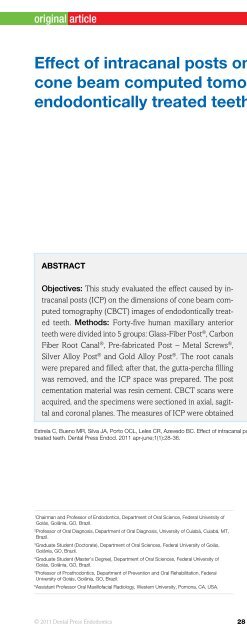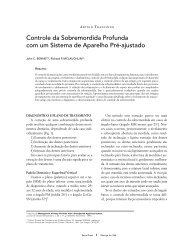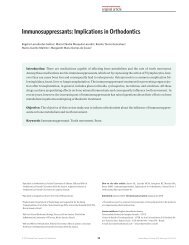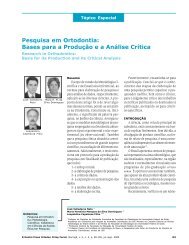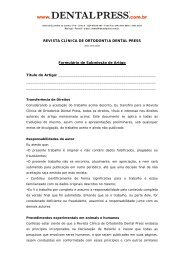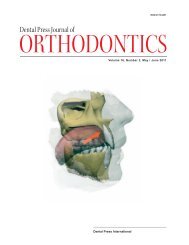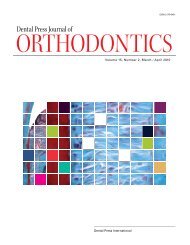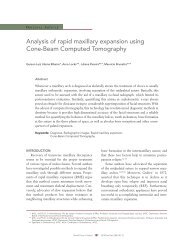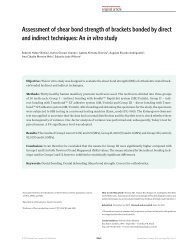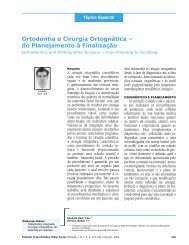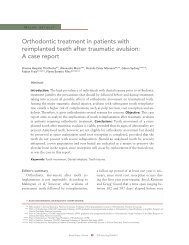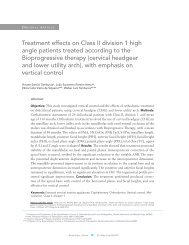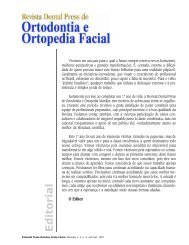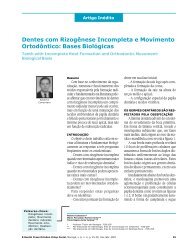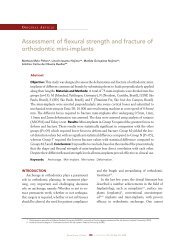Dental Press
Dental Press
Dental Press
You also want an ePaper? Increase the reach of your titles
YUMPU automatically turns print PDFs into web optimized ePapers that Google loves.
[ original article ] Analysis of forces developed during root canal filling by different operatorsadequate force of condensation in different techniquesof root canal filling, without generating excessive andunnecessary stress to root dentin.The results of this study demonstrated that there wasa variation in the load forces in magnitude as well as inconstancy applied by each of the five endodontists. Theloads averaged professionals A, C, D and E, are consistentwith the loads found in previous studies. 6,7,8The behaviors registered from professionals A and E,as shown in graphs were similar. A practically constantload force was maintained from the beginning of obturation,from the insertion of the first cones to its end,with vertical condensation of gutta-percha and theirgraphs presented a constant curve from the beginningto the end of the procedures. The professionals differedfrom each other regarding the magnitude of the forceapplied during the whole procedure. The mean value ofthe loading forces applied by professional A (2.49 Kg)was different from professional E (1.18 Kg). Regardingthe usage of finger spreaders, it could be verified thatboth professionals applied an apically directed pressure,inserting the spreader from 1 to 2 mm short the workinglength during lateral condensation.Professionals B and C also demonstrated similarbehavior regarding the distribution of the applied effortand not the magnitude of the loading force. Graphsshow an upward curve, revealing that this professionalsstarted obturation using a small amount of force whichwas increasing until the canals were completely filled.In relation to the magnitude of the applied load, a greatdifference could be verified amongst theses operators.The mean value of loading forces exercised by professionalB was 3.75 Kg and by professional C 2.24 Kg,both distributed in an increasing way.The graph generated from professional’s D behaviorduring lateral condensation was similar to professionals’A and E graphs, as a constant load was applied inthis stage of the procedure. In the moment of verticalcondensation, an increase of applied effort was verified,which was demonstrated by a peak in the curve,comparing to the force that had been previously exercised.This way, operator D ranged from a constant lowforce to a higher one during vertical condensation. Thisincrease of loading force during vertical condensationcould be also observed during the tests of operator B,but varying its mean values: 2.88 Kg for professional Dand 4.20 Kg for professional B.Investigating the maximum load force applied byfinger spreaders and capable of inducing root fracture,Holcomb, Pitts and Nicholls 9 observed the presenceof vertical fracture in teeth tested with a loading forceranging from 1.5 to 3.5 kg. These values are close tothe ones registered from the test of operator B. However,the groups of teeth tested this previous study 9 hadsmaller dimensions when compared to the teeth usedthis research, which could explain the fracturing of rootssubmitted to smaller forces.None of the five endodontists has reached the maximumfracture resistance load fracture because the pressureapplied during the lateral and vertical condensationwas insufficient. However, studies show that this techniqueof obturation may cause major defects in the rootdentin 12 than noncompaction canal filling was used. 1The most common defects are the fissure lines andcracks in the root dentin that can result after conclusionof endodontic treatment in vertical root fracture, 6,7,11 becausethe simply by forces applied to the root duringmastication 1 and additional treatments such as postspacepreparation. 2Each of the five endodontists examined demonstrateda different working profile when performing thesame obturation technique and taking in account thatthe radiographic images revealed a satisfactory andhomogenous obturation mass in all specimens. Facingthese results, it is recommended that during the processof lateral condensation, professionals apply a constantloading and reduced pressure in the apical direction,always respecting the limit of work and the space providedby the finger spreader. In the vertical condensation,in which we found three endodontists (B, C and D)within the highest values of force applied during the rootcanal filling, it is recommended using the plugger with areduced loading in the apical direction. This is becauseincrease of loading did not generate radiographic improvementin the final result of the filling, and can generated,especially in weakened or less dentinal structureroots, the appearance of defects such as fissure linesand/or incomplete cracks. 1 Following these recommendations,the professional will obtain a proper rootcanal filling, generating little stress on dentin structures.What is an important factor, as the vertical root fracturedo not occur instantly, but are, indeed a result of agradual diminishment of root structure coupled with theuse of force and pressure to root dentin. 1© 2011 <strong>Dental</strong> <strong>Press</strong> Endodontics 56 <strong>Dental</strong> <strong>Press</strong> Endod. 2011 apr-june;1(1):52-7


